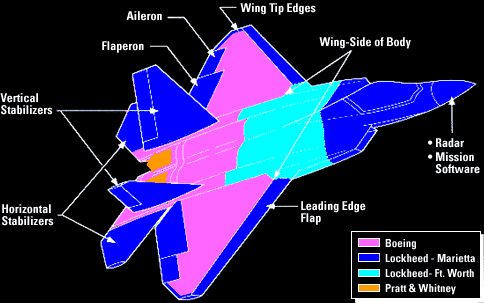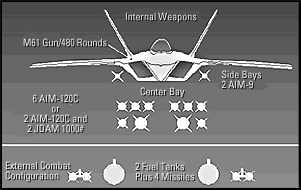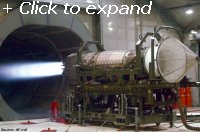Air-Attack.com > Military Systems > F-22 Raptor
F-22 Raptor
Related News

Advanced Tactical Fighter
The F-22 Raptor advanced tactical fighter aircraft is being developed for service with the US Air Force from the year 2005. The USAF requirement is for a fighter to replace the F-15. The F-22 won the Air Force's Advanced Tactical Fighter contest over the Northrop YF-23 in April 1991.
The Program
 Two prototypes of both the YF-22 and YF-23 were constructed, one example of each aircraft being powered by Pratt & Whitney F119 turbofans and the other by the General Electric F120 turbofans allowing the Air Force to select the best airframe/propulsion arrangement.
Two prototypes of both the YF-22 and YF-23 were constructed, one example of each aircraft being powered by Pratt & Whitney F119 turbofans and the other by the General Electric F120 turbofans allowing the Air Force to select the best airframe/propulsion arrangement. The second YF-22 prototype, fitted with the Pratt & Whitney engines, demonstrated the ability to cruise at Mach 1.58 without afterburner and Mach 1.7 with afterburner.
This combination was deemed the most desirable and both Lockheed and Pratt & Whitney were issued contracts to proceed with production. The first F-22 fighter aircraft was unveiled in April 1997 and was given the name Raptor.
The production F-22 aircraft includes a number of modifications when compared to the prototype.
Systems
The F-22 is characterized by a low-observable, highly maneuverable airframe; advanced integrated avionics; and aerodynamic performance allowing supersonic cruise without afterburner.The F-22 construction is 39% titanium, 24% composite, 16% aluminum and 1% thermoplastic by weight. Titanium is used for its high strength-to-weight ratio in critical stress areas, including some of the bulkheads, and also for its heat-resistant qualities in the hot sections of the aircraft. Carbon fibre composites have been used for the fuselage frame, the doors, intermediate spars on the wings, and for the honeycomb sandwich construction skin panels.
The parts of the F-22 will not be build by Lockheed alone;

The cockpit is fitted with hands-on throttle and stick control (HOTAS). The cockpit has six color liquid crystal displays. The primary multifunction dDisplay provides a plan view of the air and ground tactical situation including threat identity, threat priority and tracking information. Two displays provide communication, navigation, identification and flight information. Three secondary displays show air and ground threats, stores management and air threat information An head-up display (HUD) shows target status, weapon status, weapon envelopes and shoot cues. A video camera records data on the HUD for post-mission analysis.
Weaponry
A modern variant of the M61 cannon is installed internally above the right air intake. The general dynamics linkless ammunition handling system holds 480 rounds of 20mm ammunition and feeds the gun at a rate of 100 rounds per second.
Propulsion
The F-22 is powered by two Pratt and Whitney F119-100 engines. The F119-100 is a low-bypass afterburning turbofan engine, providing 156kN thrust.The F119 has 40% fewer major parts than current fighter engines, and each part is more durable and does its job more efficiently. Computational fluid dynamics-airflow analyzed through advanced computers-led to the design of engine turbomachinery of unprecedented efficiency, giving the F119 more thrust with fewer turbine stages.
In fact, the F119-PW-100 engine develops more than twice the thrust of current engines under supersonic conditions, and more thrust without afterburner than conventional engines with afterburner. Each F-22 will be powered by two of these 35,000-pound-thrust-class engines. By comparison, the engines powering the Air Force F-15 and F-16 fighters have thrust ratings ranging from 23,000 to 29,000 pounds.

The F119 engine nozzle for the F-22 is the world's first full production vectoring nozzle, fully integrated into the aircraft/ engine combination as original equipment. The two-dimensional nozzle vectors thrust 20 degrees up and down for improved aircraft agility. This vectoring increases the roll rate of the aircraft by 50%, and has features that contribute to the aircraft stealth requirements. Heat-resistant components give the nozzles the durability needed to vector thrust, even in afterburner conditions. With precision digital controls, the nozzles work like another aircraft flight control surface. Thrust vectoring is an integrated part of the F-22's flight control system, which allows for seamless integration of all components working in response to pilot commands.

Dec. 21st, 2004 - F/A-22 Crashes at Nellis AFB
The pilot of a Raptor stealth fighter managed to eject Monday afternoon shortly before the plane crashed at Nellis Air Force Base.
The pilot was taken to a nearby hospital, Air Force officials said. The pilot's name and condition were unavailable.
The F/A-22 crashed about 3:45 p.m., military officials said.
A huge plume of black smoke could be seen near one of the runways on the base near Las Vegas.
The aircraft, considered the Air Force's premier fighter, was assigned to the 422 Test and Evaluation Squadron at Nellis.
Air-Attack.com News Article: F/A-22 Crashes at Nellis AFB, Pilot Ejected Safely

Specifications
| Manufacturer: | Lockheed Martin | Wing Span: | 44.5 ft or 13,4 m | Length: | 62.08 ft or 18,6 m | Height: | 16.67ft or 5 m | Wing Area: | 840 sq ft | Propulsion: | Two Pratt & Whitney F119-PW-100 engines | Engine Thrust: | 35,000 lb | Speed: | Mach 1.8 (supercruise: Mach 1.5) | Crew: | One | First Flight: | September 7, 2024 |
F22 Raptor Images:








